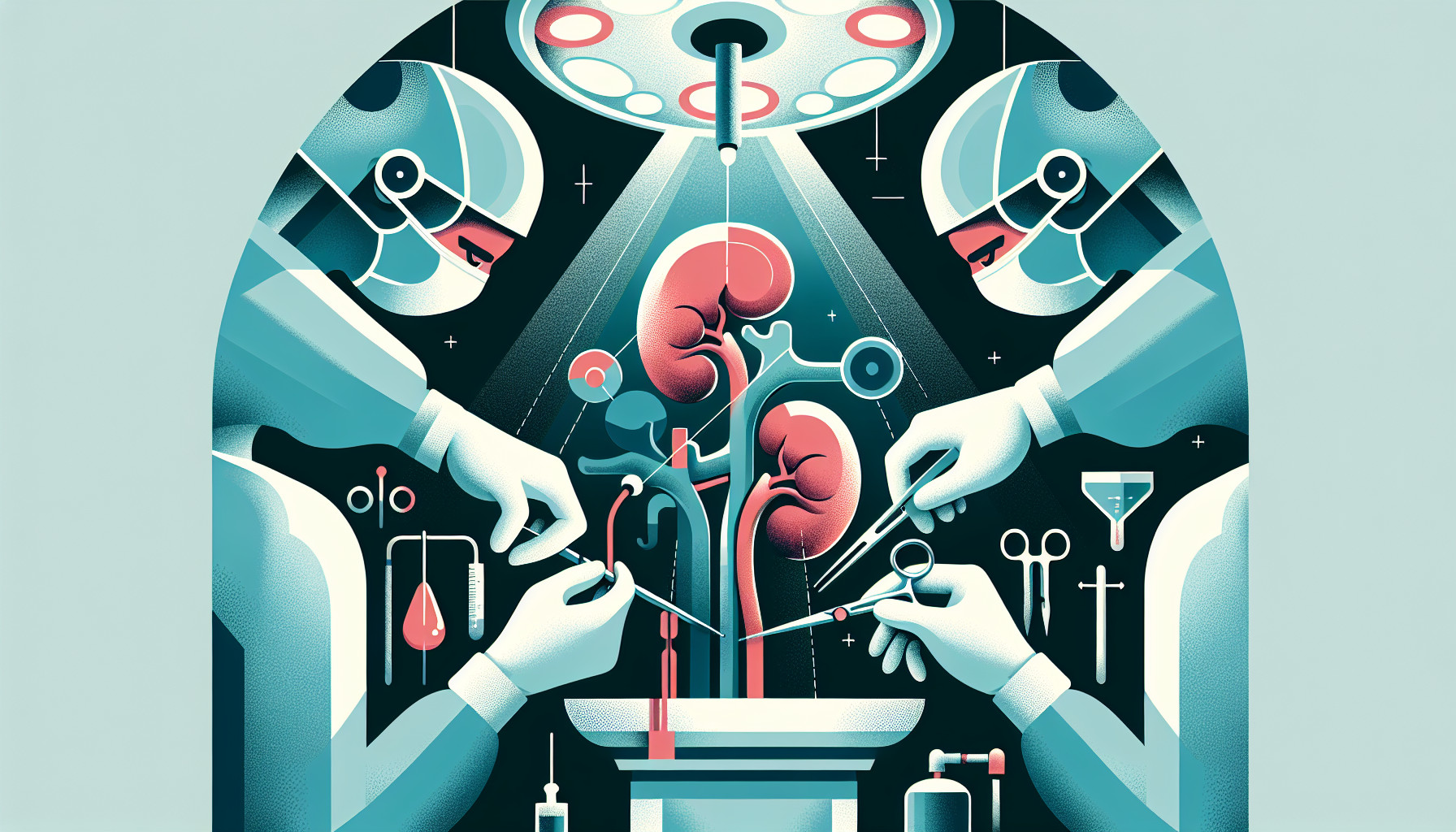Our Summary
This research paper is about the use of a surgical technique called laparoscopic partial nephrectomy (LPN) to treat small kidney tumors. The procedure is difficult to perform, but the researchers have developed a method that doesn’t require internal stitching.
They tested this technique on 31 patients with localized kidney tumors at two hospitals in Taiwan between 2009 and 2015. They used a layered approach to cover the surgical area with different substances, including FloSeal and Tisseel, as well as a fat pad, after using an electric current to stop bleeding.
The patients ranged in age from 39 to 70, and the tumors ranged in size from 1.8 to 6.3 cm. On average, the surgery took about 188 minutes, and the time the kidney was without blood supply (warm ischemic time) was about 19 minutes. The average blood loss was 171 ml, but none of the patients had bleeding after the surgery. There were also no cases of the tumor coming back after an average of 29 months. The average change in the rate at which the kidneys filter blood was 6.5 ml/min/m2.
In conclusion, the researchers say this technique for LPN is a good option for most patients with small, stage 1 tumors. It reduces the time the kidney is without blood supply and has excellent results without affecting the chance of the cancer returning. It also allows surgeons to perform the procedure more efficiently and with fewer complications.
FAQs
- What is the laparoscopic partial nephrectomy (LPN) technique for treating kidney tumors?
- How effective was the new method tested on the 31 patients in Taiwan in terms of complications and tumor recurrence?
- What are the benefits of using this technique for LPN according to the research findings?
Doctor’s Tip
A helpful tip that a doctor might tell a patient about laparoscopic nephrectomy is to carefully follow post-operative instructions for recovery, including avoiding heavy lifting, staying hydrated, and taking prescribed medications as directed. It is important to attend all follow-up appointments to monitor healing and ensure optimal outcomes. Additionally, maintaining a healthy lifestyle with regular exercise and a balanced diet can help support overall kidney health.
Suitable For
Patients who are typically recommended for laparoscopic nephrectomy include those with small kidney tumors, specifically stage 1 tumors. These patients should be in good overall health and have a tumor that is localized to the kidney and has not spread to other parts of the body. Additionally, patients should have adequate kidney function and be able to tolerate the surgical procedure.
In the study mentioned above, the patients ranged in age from 39 to 70 years old, and the tumors ranged in size from 1.8 to 6.3 cm. The researchers found that the laparoscopic partial nephrectomy technique they used was effective in treating these patients, with minimal blood loss and no cases of bleeding or tumor recurrence after an average follow-up of 29 months.
Overall, laparoscopic nephrectomy is a good option for patients with small, localized kidney tumors who are deemed suitable candidates for surgery. It offers a less invasive approach compared to traditional open surgery and can lead to excellent outcomes with a low risk of complications.
Timeline
Before the laparoscopic nephrectomy, the patient would likely undergo various tests and consultations to determine the best course of treatment for their kidney tumor. This may include imaging tests, blood work, and discussions with their healthcare team.
During the laparoscopic nephrectomy procedure, the patient would be placed under general anesthesia and small incisions would be made in the abdomen to insert a laparoscope and other surgical instruments. The surgeon would then remove the affected kidney or part of the kidney containing the tumor.
After the surgery, the patient would likely stay in the hospital for a few days for monitoring and recovery. They may experience some pain and discomfort at the incision sites, but this can be managed with medication. The patient may also need to follow up with their healthcare team for post-operative care and monitoring.
Overall, laparoscopic nephrectomy is a minimally invasive procedure that can offer quicker recovery times and less scarring compared to traditional open surgery for kidney tumors. It is important for patients to follow their healthcare team’s recommendations for post-operative care to ensure a successful recovery.
What to Ask Your Doctor
Some questions a patient should ask their doctor about laparoscopic nephrectomy include:
- What are the potential risks and complications associated with laparoscopic nephrectomy?
- How long is the recovery process after laparoscopic nephrectomy?
- Will I need any additional treatments or follow-up care after the surgery?
- How will my kidney function be affected after undergoing laparoscopic nephrectomy?
- What are the chances of the tumor coming back after laparoscopic nephrectomy?
- Are there any alternative treatment options available for my kidney tumor?
- How experienced are you in performing laparoscopic nephrectomy procedures?
- Will I need to make any lifestyle changes or follow a specific diet after the surgery?
- What can I expect in terms of pain management during and after the procedure?
- Are there any restrictions on physical activity or work after laparoscopic nephrectomy?
Reference
Authors: Li CC, Yeh HC, Lee HY, Li WM, Ke HL, Hsu AH, Lee MH, Tsai CC, Chueh KS, Huang CN, Chou YH, Li CF, Wu WJ. Journal: Surg Endosc. 2016 Apr;30(4):1585-91. doi: 10.1007/s00464-015-4382-8. Epub 2015 Jul 11. PMID: 26162423
